Coming out of Eastern Washington of the Big Sky Conference, Rodney Stuckey was a prototypical small school success story an explosive scorer who made a name for himself in just two seasons thanks to his penchant for carrying his team. Standing 6'5" with a sturdy 205 lb frame, Stuckey began drawing comparisons to Dwayne Wade leading up to the 2007 NBA Draft.
While such comparisons were obviously quite premature, Stuckey has seen his role expand and his production improve in his short career with the Pistons, being named Eastern Conference Player of the Week for December 7-13, 2009. Although many questions continue to circulate about which role Stuckey should play in Detroit, theres no doubting that hes come a long way from the days he spent at Eastern Washington.
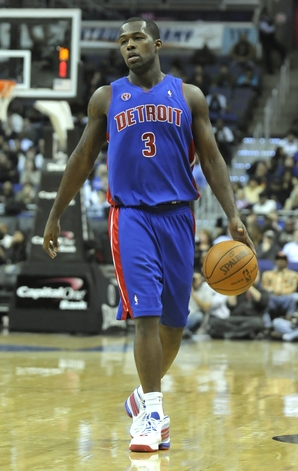
Part One: Perimeter Scoring & Shooting
Then
"Stuckey doesnt have great shooting mechanics (he has a slight hitch in his jump-shot, which leads to an inconsistent release point), but he does have great scoring instincts and a quick release, which often allow him to just throw the ball in the hoop. He has a full array of jabs, changes of speeds and hesitation moves he uses to keep his man off balance, and hes absolutely terrific at stopping abruptly and using his strength to create excellent separation from his defender. Once he gets to the basket, or tempts his man into biting for a pump-fake, hes excellent at finishing with contact thanks to his developed body."
- Filling in the Blanks: Rodney Stuckey - 6/13/07
"Stuckey is not as bad a shooter as his percentages might indicate (27% 3P as a sophomore, 37% as a freshman)its his shot-selection that really hurt him more than anything. The fact that he was forced to dominate the ball so much playing alongside considerably less talented teammates than him (and thats probably being generous) also contributed to those numbers."
- Filling in the Blanks: Rodney Stuckey - 6/13/07
Now:
The most glaring weakness in Stuckey's perimeter game is his inability to score in catch and shoot situations (0.72 Point Per Possession (PPP), 33.3% FG%). In watching film, its apparent that Stuckey hasn't fixed the hitch we previously reported in his jump shot. When he's operating in the mid-range area, Stuckey hides the hitch fairly well; however, this inconsistency plagues him on long-range jumpers, as it puts him out of rhythm when he hasnt put the ball on the floor.
If Stuckey spent the offseason working on improving his shooting mechanics, it wouldnt be surprising to see his three-point percentage climb towards respectability, which would open up his offensive game considerably. After all, he is a fairly natural shot-maker, and did shoot 30% from downtown last year. However, his current 20.4% shooting make last years numbers seem like a mirage, especially considering Stuckeys 3-point shooting woes during his rookie season (18.8% 3FG%).
Stuckey somewhat compensates for his lack of long-range accuracy with an average mid-range game. His combination of size, strength and athleticism allows him to easily maneuver and create his own shot in the mid-range area, but his selfish head-down tendency when driving certainly hinders his mid-range efficiency (0.68 PPP, 34.2% FG from 17-feet to 3-point line).
Help side defenders know when Stuckey lowers his shoulder, hes going to force a shot, so defenses converge hard to the paint on all his dribble penetration. Even with a clogged post area Stuckey rarely kicks the ball out to open shooters. Instead, he prefers higher degree of difficulty shots, which typically yield negative results for the Pistons, and discourage the notion that hes best suited playing a primary ball-handling and playmaking role.
He could get away with forced shot attempts like this at Eastern Washington and simply wasnt taking as many in a smaller role earlier in his career, but Stuckey needs to adapt his dribble drive game to include passes and smarter decisions to improve his teams scoring efficiency.
Stuckey doesnt see a great deal of time off the ball trying to get open looks at the basket, as the Pistons need the ball in his hands a great deal as their primary shot-creator. According to Synergy Sports Technology, Stuckey only utilizes off-ball screens on 5% of his possessions, while spending 24% of the time in isolation and 24% of possessions in pick and roll scenarios. This play-type breakdown clearly demonstrates Stuckeys role in the Pistons' offense.
In fact, his play type stats this season are right on par with how hes been contributing to the Pistons offense since entering the league (2007 24% P&R, 20% Iso; 2008 21% P&R, 23% Iso). He was after all anointed a star immediately upon arrival and treated as such in terms of the amount of freedom he was given. He now sports one of the highest usage rates in the entire NBAon par with many of the leagues superstars, although hes yet to prove that he can warrant shouldering such a heavy load. Ball-dominant point guards tend to exhibit much worse shooting percentages and efficiency statistics than those who play distributive roles, and its unfortunate that Detroit hasnt done a better job of helping him become more efficient offensively. We knocked this part of Stuckeys game coming out of college, and thus far in his NBA career he has not been an exception to the rule.
Part Two: Getting to the Basket & Athleticism
Then:
"Stuckeys fantastic first step (going both left and right) combined with his fearlessness and excellent strength give him immediate solutions to almost anything thrown his wayhed often for example just split the traps right through the middle and make his way straight to the basket. He turns the corner incredibly well and got into the paint repeatedly in the games we saw, doing a great job finishing in traffic with contact, thanks in large part to his excellent body control."
- DraftExpress All-Summer League: First Team - 7/23/07
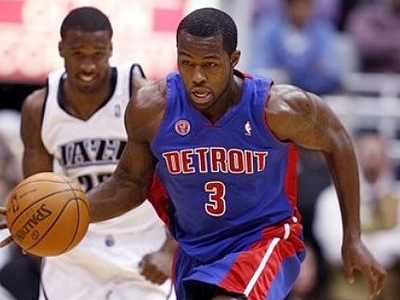
Now:
Stuckey still possesses the explosive strength and quick first step that we saw several summers ago. His ability to penetrate defenses and create contact near the hoop is evidenced by his 5.1 FTA per game this season (T-7th among point guards) and 34 "and-one" finishes (3rd amongst guards). The major flaw in Stuckey's dribble-drive game is his tendency to lower his head and "bulldoze" his way to the rim. If he did a better job of reading defenses and picking and choosing his spots better, hed be much more efficient exploiting the mismatch opportunities his athleticism creates, but as Detroits de facto first option--in large part due to the fact that they have no post presence and very few legit shot-creators--hes often forcing such drives against longer, more athletic players that teams use in order to neutralize him.
In some cases, Stuckeys aggressive dribble attack results in spectacular finishes, but his scoring numbers around the basket (0.83 PPS, 40.8% FG) tell a different story than the highlight plays casual NBA fans associate with him. Hes currently the centerpiece of the Pistons offense, which forces his hand to a degree when it comes to scoring the ball, but it would help his team immensely if he deferred (or was better able to defer) some of the pressure to his teammates by being more discerning with his shots at the basket. Considering hes only shooting 40.6% from the field and putting up sub-par passing numbers, one could say Stuckey is playing more like Allen Iverson than Chauncey Billups, which most Pistons fans would not consider a compliment.
In order to improve his pedestrian efficiency statistics, Stuckey needs to become more adept at reading help side defenses, limit his over-penetration, and develop the efficiency of his pull-up game from the 10-12 foot area. As Detroit gets healthy and is able to surround him with better talent in the post and on the wings, his ability to make those adjustments will be an important part of his development as a player.
Part Three: Guard Skills & Decision-Making
Then:
"Stuckey made good decisions for the most part in the half-court set, looking to execute the plays relayed to him from the sidelines and not having any problem at all feeding his teammates. He took what the defenses gave him on pick and roll plays and did not get flustered when trapped/double-teamed at the top of the key. Stuckey didnt get caught up in the type of stubborn over-dribbling that we typically see from mid-major combo guards, which is a great sign as far as his future development within Detroits offense is concerned."
- DraftExpress All-Summer League: First Team - 7/23/07
"His court vision is very solid, particularly threading the needle to cutters from the perimeter, driving and dishing in traffic, or finding open teammates in transition. Despite the 17+ shots he took per game, he doesnt come off as a selfish player when watching him on tape, even when Eastern Washington played against much more talented opponents like Washington or Gonzaga and he was forced to shoulder a considerable amount of the scoring load. He did average 5.5 assists per game on the season after all. That doesnt mean that Stuckey is necessarily ready to be a point guard either, though. For one, his decision making skills can be really poor at times, forcing up ill-advised shots early in the shot-clock, lowering his shoulder and driving into a brick wall, or trying to make high degree of difficulty passes in half-court sets, leading to unnecessary turnovers."
- Filling in the Blanks: Rodney Stuckey - 6/13/07
Now:
Most of what we previously documented about Stuckey's decision-making roller coaster has held true through the first three years of his NBA career. During stretches, Stuckey seemed en route to developing into a true point guard, but this season he's shouldered more of the Pistons' scoring load and isnt distributing the ball as effectively. His 19.1% assist rate (down from 24.3% last season), 5.6 assists per-40 pace adjusted (55th in NBA), and decent 2.01 assist-to-turnover ratio suggest a shoot-first mentality that may be systematic or a characteristic of Stuckeys game at this point. At times, his teammates even seem alienated and tend to stand around and watch Stuckey play one-on-five off the bounce. Ag
In Stuckeys defense, the Pistons have been plagued by injuries this year and just recently returned Richard Hamilton and Tayshaun Prince from injury after each missed nearly the first two months of action. All things considered, we should see an increase in Stuckey's passing efficiency and a decrease in his usage rate with the team's starting lineup healthy, even if neither Hamilton or Prince are considered great ball-handlers or shot-creators. If his passing numbers and shooting percentages remain this low by season's end, Detroit will certainly reevaluate its offensive attack and might be forced reassess Stuckeys role. At the moment it seems like Prince and Hamilton may be the ones on their way out, though.
Part Four: Defense
Then:
"Defensively, Stuckey has great physical tools and competes pretty hard on top of that, but hell look pretty clueless at times getting caught underneath screens for example or gambling for a steal. His learning curve on this end of the floor could very well be the deciding factor in how much he ends up playing in his rookie season under the defensive-minded Flip Saunders."
- DraftExpress All-Summer League: First Team - 7/23/07
"Stuckey is a tough and pretty strong defender, able to get into the passing lanes and not afraid to stick his nose in at times and take a charge. He mainly relies on his physical tools and activity level, though, not being the most aware guy in the world as far as defensive rotations or always staying in front of his man goes. He does have good potential here, though, if hes willing to put in the time and effort. Thats going to be a key factor in whether he develops into a solid rotation player, or even much more than that.
- Filling in the Blanks: Rodney Stuckey - 6/13/07
Now:
Stuckey, drafted primarily for his offensive talents, has greatly improved his defensive awareness in his three seasons as a pro. He utilizes his size, strength, and solid work ethic to keep the ball in front of him, but is prone to over-committing to help-side defense which limits his ability to make effective rotations against half court sets. His steal numbers have slightly improved during each of his seasons in the NBA (1.4 STL/G this season), and his length is extremely bothersome for opposing point guards.
While Stuckey plays decent defense in isolation situations, he isnt as effective when defending the pick and roll. Much of defending pick and roll situations falls on team defense, and Stuckey seems far too casual when encountering ball screens. The Pistons aggressively hedge ball screens, which requires Stuckey to quickly recover to the ball handler to allow the helping big to retreat to the paint. Stuckeys failure to make crisp rotations often provides the opposing guard a free mid-range look against a mismatched post player.
Another question mark in Stuckeys defense lies in his rebounding ability. By making a more concerted effort to utilize his physical gifts and box out, Stuckey would help the Pistons limit second chance points. Putting a body on someone will also give Stuckey a statistical boost over his 5.0 rebounds per-40 pace adjusted. He may never be Jason Kidd, but Stuckey is certainly more capable on the glass than his averages suggest. A big, strong guard with good leaping ability, it would be nice to see him give a better effort, though his numbers can be attributed in part to the players around him.
Part Five: Intangibles
Then:
Showing impressive poise for a rookie at both guard positions, Rodney Stuckey got a great run in at the Vegas Summer League and looks well ahead of schedule relative to what we expected from him.
- DraftExpress All-Summer League: First Team - 7/23/07
Now:
Throughout the Pistons struggles this season, Stuckey has been a model citizen. Before their January 16th game against the New York Knicks, Stuckey spent the night in the hospital battling dehydration and flu-related symptoms. After an impressive performance (20 pts, 4 reb, 4 ast) and close 94-90 victory, Stuckey cemented his place as the leader of Detroits locker room:
I will fight through it, Stuckey said. Last night, I did not get home until about 4 oclock from the hospital because I had to get an IV. I will just fight through it. When BG (Ben Gordon) and Will (Bynum) get back, maybe I will get some rest, but for now I have to keep fighting.
-http://www.theoaklandpress.com/articles/2010/01/17/sports/doc4b52917f0b094976585471.txt
Given his response to this seasons adversity, Stuckey will clearly be a big factor for his team in years to come. Its unfortunate that questions regarding his position and the huge role hes forced to shoulder often overshadow just how impressive his transition from small-college stud to NBA starter has been. Though Stuckey certainly deserves credit for taking things in stride, until the Pistons start winning games, hell continue to field criticisms.














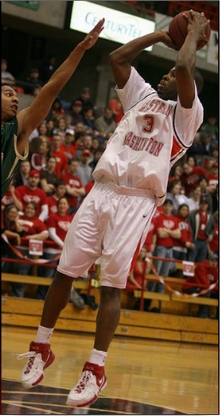


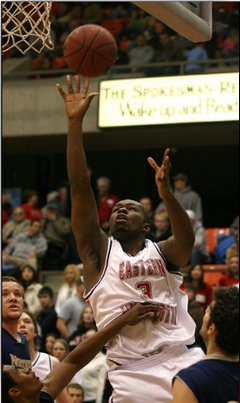
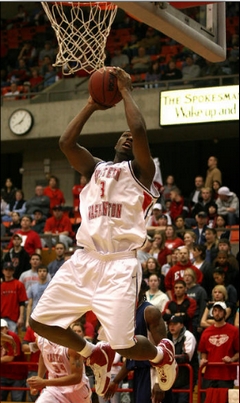






Comments